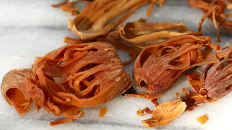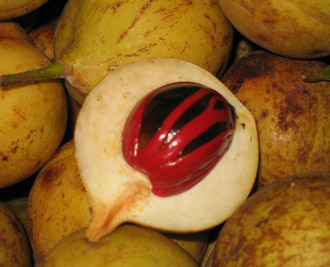Mace spice nutrition facts
Mace spice is a dried, outer aril, enveloping firmly around the nutmeg kernel. Nutmeg kernel and mace arils indeed are two separate spice products of the same nutmeg fruit. However, spice-mace has characteristically composed a higher concentration of certain essential oils and features a refined yet more intense aroma than nutmeg. For the same reasons, it commands a higher price and a special place in the kitchen spice box!

|
| Note crimson-red color dried mace spice. |
There are several species of nutmeg grown all over the world other than Myristica species, such as M. argentea, M. malabarica (Indian), and M. fatua. They are rather similar to M. fragrans in appearance, however, inferior in flavor and aroma.
Botanically, the nutmeg fruit is a drupe-like an apricot. Once completely ripened, it splits open at its bottom (basal) end to reveal a single, centrally situated oval-shaped hard seed (kernel), known commercially as the “nutmeg.” Adhering closely to this nutmeg kernel are crimson-red, lacy, or thread-like arils known as mace spice. This mace aril is then carefully peeled off the nutmeg kernel either by hand or using a knife. It is then allowed to dry under the shade for 3-4 days.
Dried mace arils, which now attained amber color are then processed and graded before being dispatched to the market.
Processing of mace spice
 |
| Raw nutmeg fruit. Note for central seed and "lacy" mace. (Photo by-giselleai) |
M. fragrant tree yields nutmeg fruits up to three times in a season. Once harvested from the tree, its outer pulp or husk is removed and discarded. Just underneath the tough hull is the golden-brown color aril, known as "mace," enveloping firmly around the nutmeg kernel. Mace is gently peeled off from the kernel surface, flattened into strips, dried, and sold either as whole "mace blades" or finely ground into powder. The nutmeg kernels are then dried under the sun for several days to weeks. At larger commercial set-ups, this process is carried out rather quickly over a hot dryer machine until the whole nutmeg rattles inside the shell.
Health benefits of mace spice
Essentially employed as an aromatic agent; mace spice significantly enhances the color, taste, and flavor of foods. Besides, it contains some of the health-benefiting antioxidant compounds, essential oils, minerals, and vitamins.
Mace features quite a different nutritional profile than nutmeg. It is less in calories but has more concentrations of essential oils, vitamin A, vitamin C, carotenes, iron, and calcium.
The spice contains fixed oil trimyristin, and many essential volatile oils, which give a sweet aromatic flavor such as myristicin, elemicin, eugenol and safrole. These oils occur in higher concentrations in mace than in nutmeg. The other less important volatile oils are pinene, camphene, di-pentene, cineole, linalool, sabinene, safrole, and terpeneol.
The active principles in mace spice have many therapeutic applications in many traditional medicines as anti-fungal, anti-depressant, aphrodisiac, digestive, and carminative functions.
Mace has more vitamin C content than nutmeg. 100 g mace spice has 21 mg against just 3 mg of nutmegs. Likewise, mace blades contain more riboflavin (vitamin B-2).
Mace arils are rather excellent sources of vitamin A. 100 g of mace provides 800 IU of vitamin A, nearly nine times more than that in nutmeg.
Mace arils contain more calcium, copper, iron and magnesium than nutmeg. 100 g of mace powder has 13.90 mg of iron when compared to just 3.04 mg of nutmeg. Manganese and copper as co-factors for the antioxidant enzyme, superoxide dismutase. Iron is essential for red blood cell production and as a co-factor for cytochrome oxidases enzymes.
| Principle | Nutrient Value | Percent of RDA |
|---|---|---|
| Energy | 475 Kcal | 24% |
| Carbohydrates | 50.50 g | 39% |
| Protein | 6.71 g | 12% |
| Total Fat | 32.38 g | 162% |
| Cholesterol | 0 mg | 0% |
| Dietary Fiber | 20.2 g | 54% |
| Vitamins | ||
| Folates | 76 µg | 19% |
| Niacin | 1.350 mg | 8% |
| Pyridoxine | 0.160 mg | 12% |
| Riboflavin | 0.448 mg | 34% |
| Thiamin | 0.312 mg | 26% |
| Vitamin-A | 800 IU | 27% |
| Vitamin C | 21 mg | 35% |
| Electrolytes | ||
| Sodium | 80 mg | 5% |
| Potassium | 463 mg | 10% |
| Minerals | ||
| Calcium | 252 mg | 25% |
| Copper | 2.467 mg | 274% |
| Iron | 13.90 mg | 174% |
| Magnesium | 163 mg | 41% |
| Manganese | 1.500 mg | 65% |
| Phosphorus | 110 mg | 30% |
| Zinc | 2.15 mg | 20% |
Medicinal uses
As in nutmeg, mace extraction has also been employed in Chinese and Indian traditional medicines for the treatment of illnesses related to the nervous and digestive systems. The compounds in this spice such as myristicin and elemicin have been found to have soothing as well as stimulant properties on the brain.
Nutmeg and mace oil contain eugenol, which has been used in dentistry for toothache relief.
The oil is also used as a local massage to reduce muscular pain and rheumatic pain of joints.
Freshly prepared mace-decoction with honey has been employed to get relief from nausea, gastritis, and indigestion ailments.
Selection and storage
In the stores, one can buy the whole mace, straight slivers known as mace blades, or ground powder packed inside air-sealed containers. Look for whole mace or its blades instead of powder since powdered mace shall lose its flavor rather quickly because of the evaporation of essential oils. The other reason is, that it oftentimes may be mixed with inferior quality mace species.
Once at home, store the whole mace spice and blades in an airtight container and place them in a cool, dark, and dry place where they can stay fresh for several months. Ground mace, however, should be stored in well-sealed packs and used as quickly as possible.
Culinary uses
Both nutmegs, as well as mace spice, are employed widely in the recipes. Although mace and nutmegs can be used interchangeably, mace has a pleasant yet more intense flavor than nutmeg and gives light saffron color to the dishes. Mace blades should be fished out before serving. Instead, they may seep into hot water, and the extraction may be directly added to the recipes.
Here are some serving tips:
Mace is sought after, particularly, in sweet dishes. It gives sweet, warm, and pleasant flavor, especially to the bakery foods like pastries, donuts, cake, etc.
In the Indian subcontinent where it is popular as javitri, found in an array of sweet and savory recipes.
It is also employed as one of the common ingredients in the spice mix, particularly in Indian garam masala powder, and Moroccan, rass-el-hanout.
Its freshly ground powder is added to meat stews, bean stews, sauces, and soups (sup kambing).
Safety profile
Consumption of large amounts of nutmeg and mace spice may cause sweating, palpitations, headache, body pain, and in severe cases, hallucination and delirium.
In very small doses, it may be used safely in pregnancy and lactation.
(Medical Disclaimer: The information and reference guides on this website are intended solely for the general information of the reader. It is not to be used to diagnose health problems or for treatment purposes. It is not a substitute for medical care provided by a licensed and qualified health professional. Please consult your health care provider for any advice on medications.)
≻≻-Read nutmeg nutrition facts.
≻≻-Back to Spices from Mace Spice. Visit here for an impressive list of healthy spices with complete illustrations of their nutrition facts and health benefits.
≻≻-Back to Home page.
Further reading:
Cooking with herbs and spices- by Andi Clevely- page 310-311.